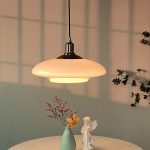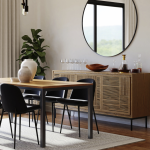
Introduction
The 1920s was a decade of parties, dance, and glamour, and it brought about many new and innovative design styles in furniture and lighting. Iconic designs of 1920s lamps are still attracting designers, historians, and collectors today. In this article, we explore some of these designs and their historical and stylistic significance.
1. Art Deco Lamps
Art Deco style emerged in the 1920s, and lamps of this style featured angular shapes and exotic materials, such as chrome and glass. The famous French designer Jacques-Emile Ruhlmann created lamps with strong geometric shapes but softened the lines with more organic curves. One of his famous designs was an inverted umbrella-shaped lamp fit with a colorful glass shade, which reflected light in myriad ways.
1.1 Stepped and Zigzag Forms
Stepped and zigzag forms were common in Art Deco lamps. These forms were derived from ancient Egyptian architecture and inspired by the discoveries during the excavation of the tomb of Tutankhamen in 1922. Lamps with zigzag forms are characterized by sharp edges and bold lines. The Egyptian Revival style that emerged during the 1920s inspired designers to create lamps with this form. The most prominent designer of this style was Edgar Brandt, who created bold and modern lamps with this distinctive style.
1.2 Glass and Chrome Materials
Art Deco lamps often used glass and chrome materials. Glass was used to create different shades of the lamp, often with a colorful or frosted finish. Chrome was used for the metal framework of the lamp, giving the lamp a sleek and modern look. This distinctive combination of materials gave the lamps a unique look, with the glass shades creating a colorful and dramatic effect when illuminated.
2. Tiffany Lamps
Tiffany Lamps were designed by Louis Comfort Tiffany and first produced in the 1890s. However, Tiffany lamps became increasingly popular in the 1920s. These lamps featured stained glass shades, often with floral or nature motifs, and illuminated in a warm and inviting manner. The lamp bases were usually made of bronze, giving the lamps a traditional and timeless look.
2.1 Nature Motifs
The stained glass shades of Tiffany lamps often featured nature motifs, such as flowers, trees, and animals. These motifs were inspired by the aesthetic movement of the 19th-century Art Nouveau style. The use of natural and organic shapes created a tranquil and soothing atmosphere.
2.2 Smooth and Delicate Lines
The lamp bases of Tiffany lamps often featured smooth and delicate lines, softening the sharp and bold shapes of Art Deco lamps. Tiffany lamps were designed to complement the beauty of the floral or nature motifs in the shades. The curves and scrolls of the lamp bases added an elegant touch to the overall design of the lamp.
3. Bauhaus Lamps
The Bauhaus movement emerged in Germany in the 1920s, and this design movement aimed to create functional and minimalistic designs. The Bauhaus lamps’ most significant characteristic was their simplicity in design and construction, with a focus on ergonomics and the use of new materials.
3.1 Simplicity in Design
Bauhaus lamps stripped away all excess decoration, focusing solely on the functional aspects of the lamp. The designs were minimalistic and functional, with a focus on the shape and construction of the lamp. The lamps were spare and practical, yet there was still a beauty in the simplicity of the design.
3.2 Ergonomic Design and Utilization of New Materials
The Bauhaus lamps’ simplicity in design also focused on ergonomics and the functionality of the lamp. New materials were also used, such as steel tubing and chrome plating, which helped create a sleek and modern look. The lamp was designed to be easy to adjust, with a focus on functionality more than aesthetics. The resulting design was sleek, elegant, and highly versatile.







